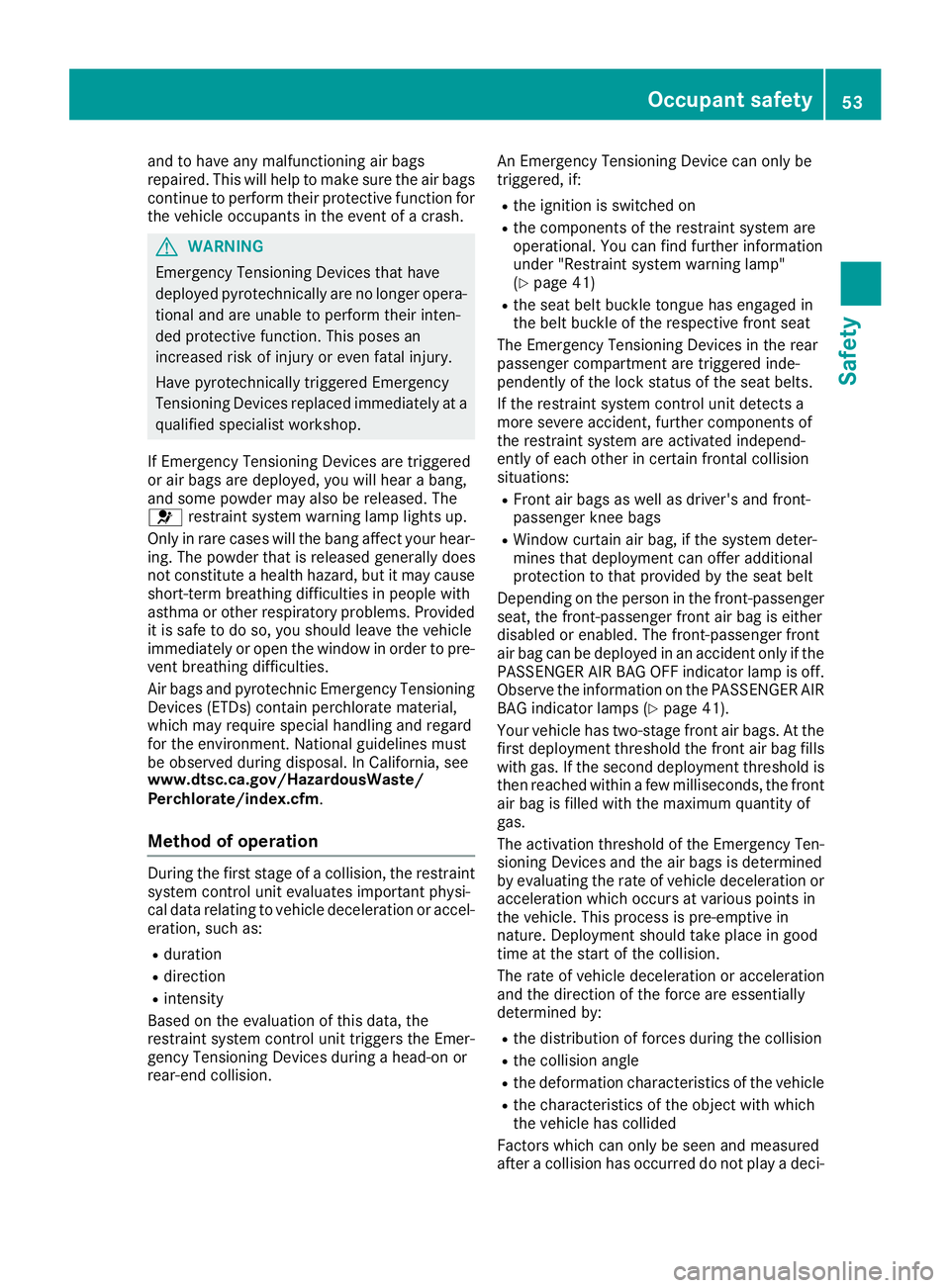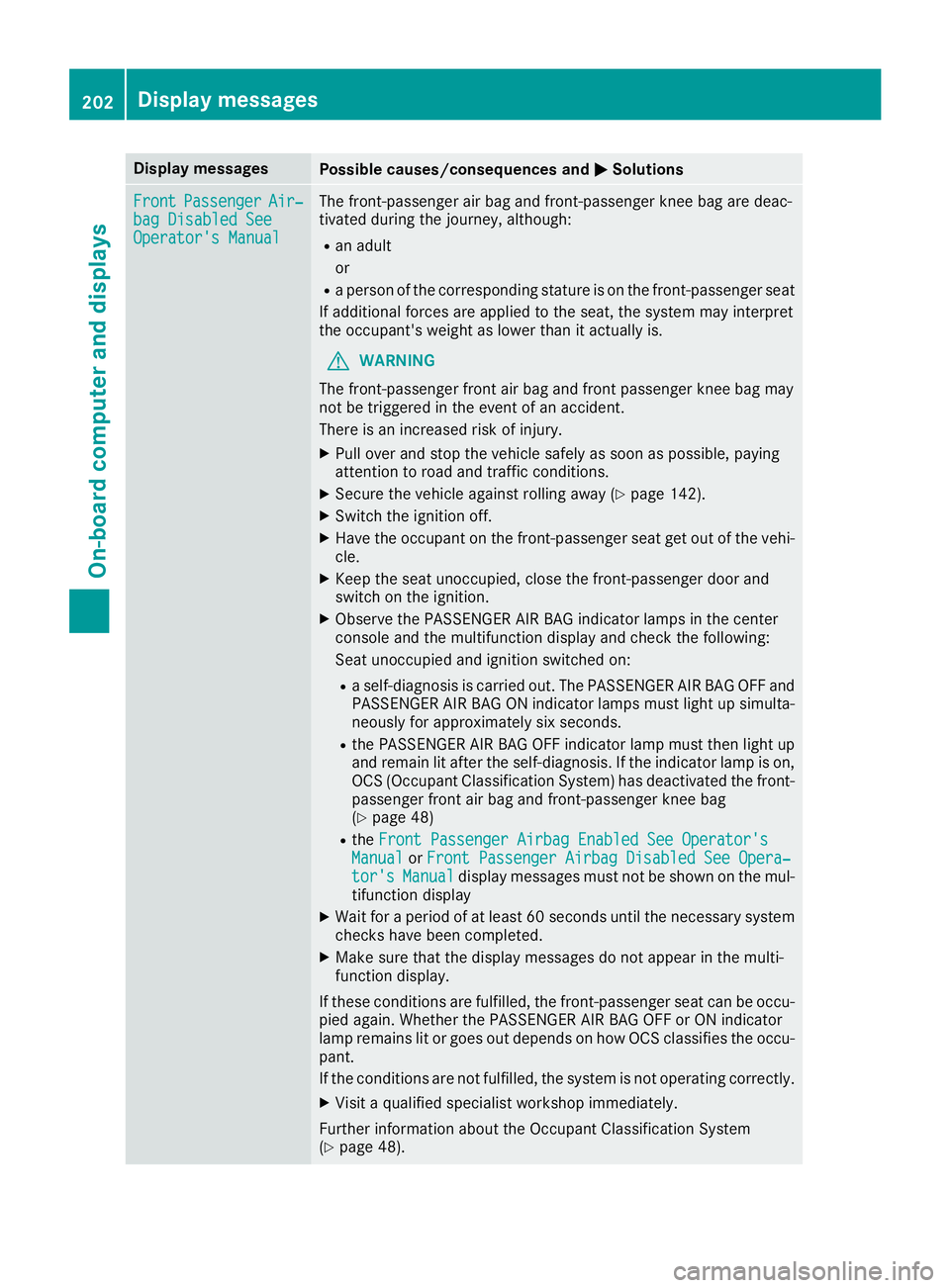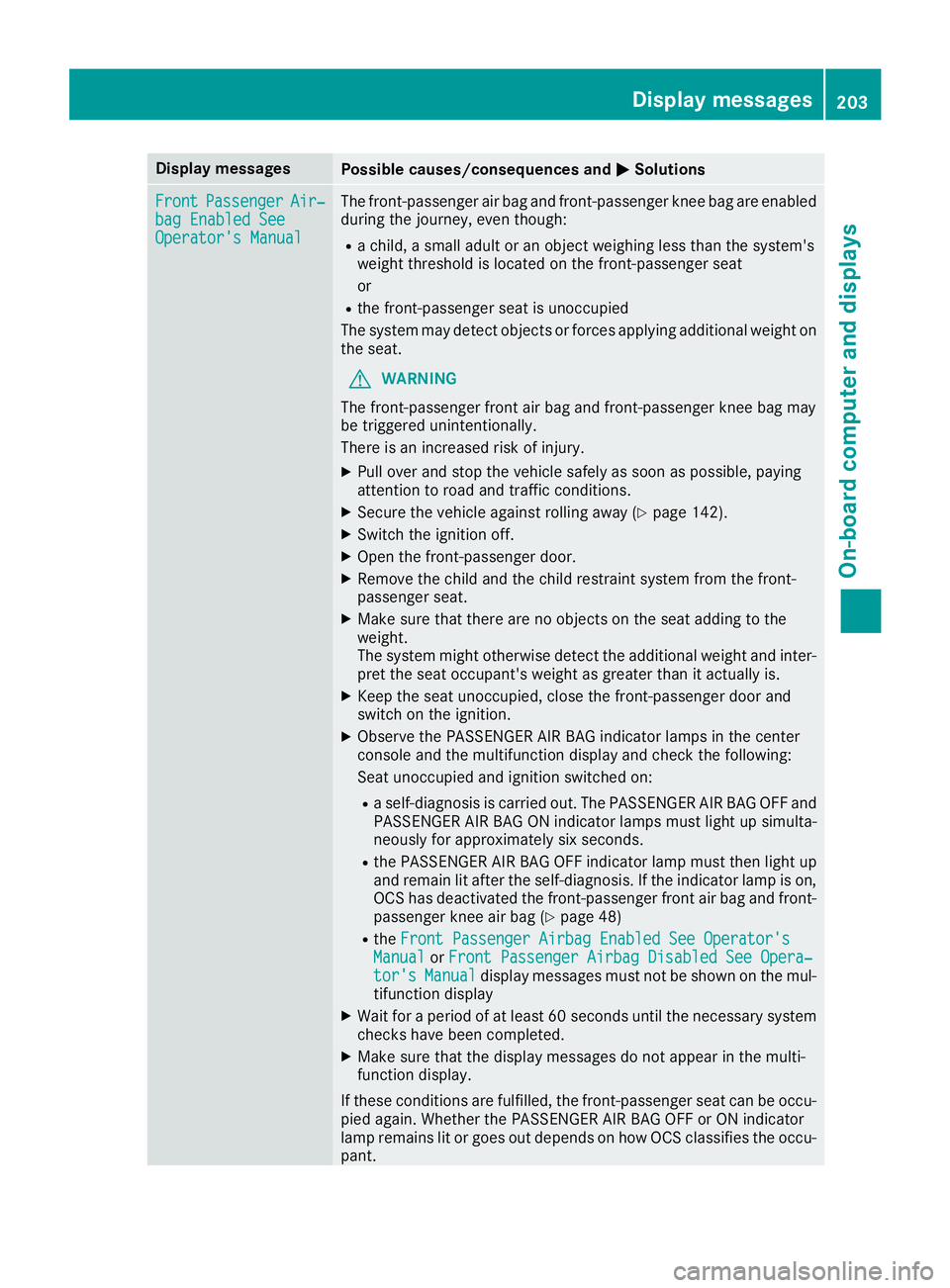2019 MERCEDES-BENZ CLA airbag disable
[x] Cancel search: airbag disablePage 55 of 330

and to have any malfunctioning air bagsrepaired. This will help to make sure the air bagscontinue to perform their protective function forthe vehicle occupants in the event of a crash.
GWARNING
Emergency Tensioning Devices that have
deployed pyrotechnically are no longer opera-
tional and are unable to perform their inten-
ded protective function. This poses an
increased risk of injury or even fatal injury.
Have pyrotechnically triggered Emergency
Tensioning Devices replaced immediately at a
qualified specialist workshop.
If Emergency Tensioning Devices are triggeredor air bags are deployed, you will hear a bang,and some powder may also be released. The�urestraint system warning lamp lights up.
Only in rare cases will the bang affect your hear-ing. The powder that is released generally doesnot constitute a health hazard, but it may causeshort-term breathing difficulties in people withasthma or other respiratory problems. Providedit is safe to do so, you should leave the vehicleimmediately or open the window in order to pre-vent breathing difficulties.
Air bags and pyrotechnic Emergency TensioningDevices (ETDs) contain perchlorate material,which may require special handling and regardfor the environment. National guidelines mustbe observed during disposal. In California, seewww.dtsc.ca.gov/HazardousWaste/Perchlorate/index.cfm.
Method of operation
During the first stage of a collision, the restraintsystem control unit evaluates important physi-cal data relating to vehicle deceleration or accel-eration, such as:
Rduration
Rdirection
Rintensity
Based on the evaluation of this data, therestraint system control unit triggers the Emer-gency Tensioning Devices during a head-on orrear-end collision.
An Emergency Tensioning Device can only betriggered, if:
Rthe ignition is switched on
Rthe components of the restraint system areoperational. You can find further informationunder "Restraint system warning lamp"(Ypage 41)
Rthe seat belt buckle tongue has engaged inthe belt buckle of the respective front seat
The Emergency Tensioning Devices in the rearpassenger compartment are triggered inde-pendently of the lock status of the seat belts.
If the restraint system control unit detects amore severe accident, further components ofthe restraint system are activated independ-ently of each other in certain frontal collisionsituations:
RFront air bags as well as driver's and front-passenger knee bags
RWindow curtain air bag, if the system deter-mines that deployment can offer additionalprotection to that provided by the seat belt
Depending on the person in the front-passengerseat, the front-passenger front air bag is eitherdisabled or enabled. The front-passenger frontair bag can be deployed in an accident only if thePASSENGER AIR BAG OFF indicator lamp is off.Observe the information on the PASSENGER AIRBAG indicator lamps (Ypage 41).
Your vehicle has two-stage front air bags. At thefirst deployment threshold the front air bag fillswith gas. If the second deployment threshold isthen reached within a few milliseconds, the frontair bag is filled with the maximum quantity ofgas.
The activation threshold of the Emergency Ten-sioning Devices and the air bags is determinedby evaluating the rate of vehicle deceleration oracceleration which occurs at various points inthe vehicle. This process is pre-emptive innature. Deployment should take place in goodtime at the start of the collision.
The rate of vehicle deceleration or accelerationand the direction of the force are essentiallydetermined by:
Rthe distribution of forces during the collision
Rthe collision angle
Rthe deformation characteristics of the vehicle
Rthe characteristics of the object with whichthe vehicle has collided
Factors which can only be seen and measuredafter a collision has occurred do not play a deci-
Occupant safety53
Safety
Z
Page 204 of 330

Display messagesPossible causes/consequences and�P�PSolutions
FrontFrontPassengerPassengerAir‐Air‐bag Disabled Seebag Disabled SeeOperator's ManualOperator's Manual
The front-passenger air bag and front-passenger knee bag are deac-tivated during the journey, although:
Ran adult
or
Ra person of the corresponding stature is on the front-passenger seat
If additional forces are applied to the seat, the system may interpretthe occupant's weight as lower than it actually is.
GWARNING
The front-passenger front air bag and front passenger knee bag maynot be triggered in the event of an accident.
There is an increased risk of injury.
XPull over and stop the vehicle safely as soon as possible, payingattention to road and traffic conditions.
XSecure the vehicle against rolling away (Ypage 142).
XSwitch the ignition off.
XHave the occupant on the front-passenger seat get out of the vehi-cle.
XKeep the seat unoccupied, close the front-passenger door andswitch on the ignition.
XObserve the PASSENGER AIR BAG indicator lamps in the centerconsole and the multifunction display and check the following:
Seat unoccupied and ignition switched on:
Ra self-diagnosis is carried out. The PASSENGER AIR BAG OFF andPASSENGER AIR BAG ON indicator lamps must light up simulta-neously for approximately six seconds.
Rthe PASSENGER AIR BAG OFF indicator lamp must then light upand remain lit after the self-diagnosis. If the indicator lamp is on,OCS (Occupant Classification System) has deactivated the front-passenger front air bag and front-passenger knee bag(Ypage 48)
RtheFront Passenger Airbag Enabled See Operator'sFront Passenger Airbag Enabled See Operator'sManualManualorFront Passenger Airbag Disabled See Opera‐Front Passenger Airbag Disabled See Opera‐tor'stor'sManualManualdisplay messages must not be shown on the mul-tifunction display
XWait for a period of at least 60 seconds until the necessary systemchecks have been completed.
XMake sure that the display messages do not appear in the multi-function display.
If these conditions are fulfilled, the front-passenger seat can be occu-pied again. Whether the PASSENGER AIR BAG OFF or ON indicatorlamp remains lit or goes out depends on how OCS classifies the occu-pant.
If the conditions are not fulfilled, the system is not operating correctly.
XVisit a qualified specialist workshop immediately.
Further information about the Occupant Classification System(Ypage 48).
202Displaymessages
On-b oard computer and displays
Page 205 of 330

Display messagesPossible causes/consequences and�P�PSolutions
FrontFrontPassengerPassengerAir‐Air‐bag Enabled Seebag Enabled SeeOperator's ManualOperator's Manual
The front-passenger air bag and front-passenger knee bag are enabledduring the journey, even though:
Ra child, a small adult or an object weighing less than the system'sweight threshold is located on the front-passenger seat
or
Rthe front-passenger seat is unoccupied
The system may detect objects or forces applying additional weight onthe seat.
GWARNING
The front-passenger front air bag and front-passenger knee bag maybe triggered unintentionally.
There is an increased risk of injury.
XPull over and stop the vehicle safely as soon as possible, payingattention to road and traffic conditions.
XSecure the vehicle against rolling away (Ypage 142).
XSwitch the ignition off.
XOpen the front-passenger door.
XRemove the child and the child restraint system from the front-passenger seat.
XMake sure that there are no objects on the seat adding to theweight.The system might otherwise detect the additional weight and inter-pret the seat occupant's weight as greater than it actually is.
XKeep the seat unoccupied, close the front-passenger door andswitch on the ignition.
XObserve the PASSENGER AIR BAG indicator lamps in the centerconsole and the multifunction display and check the following:
Seat unoccupied and ignition switched on:
Ra self-diagnosis is carried out. The PASSENGER AIR BAG OFF andPASSENGER AIR BAG ON indicator lamps must light up simulta-neously for approximately six seconds.
Rthe PASSENGER AIR BAG OFF indicator lamp must then light upand remain lit after the self-diagnosis. If the indicator lamp is on,OCS has deactivated the front-passenger front air bag and front-passenger knee air bag (Ypage 48)
RtheFront Passenger Airbag Enabled See Operator'sFront Passenger Airbag Enabled See Operator'sManualManualorFront Passenger Airbag Disabled See Opera‐Front Passenger Airbag Disabled See Opera‐tor'stor'sManualManualdisplay messages must not be shown on the mul-tifunction display
XWait for a period of at least 60 seconds until the necessary systemchecks have been completed.
XMake sure that the display messages do not appear in the multi-function display.
If these conditions are fulfilled, the front-passenger seat can be occu-pied again. Whether the PASSENGER AIR BAG OFF or ON indicatorlamp remains lit or goes out depends on how OCS classifies the occu-pant.
Displaymessages203
On-b oard computer and displays
Z